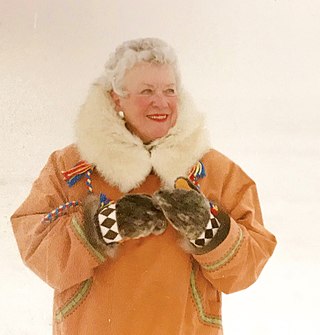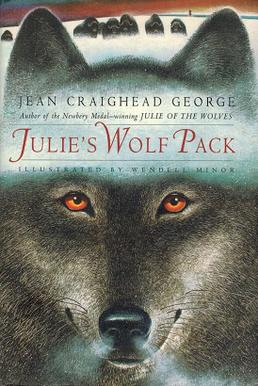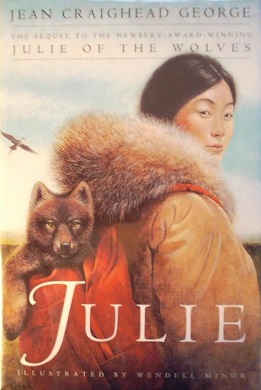
Utqiaġvik, is the borough seat and largest city of the North Slope Borough in the U.S. state of Alaska. Located north of the Arctic Circle, it is one of the northernmost cities and towns in the world and the northernmost in the United States, with nearby Point Barrow which is the country's northernmost land.

The Iñupiat are a group of indigenous Alaskans whose traditional territory roughly spans northeast from Norton Sound on the Bering Sea to the northernmost part of the Canada–United States border. Their current communities include 34 villages across Iñupiat Nunaat, including seven Alaskan villages in the North Slope Borough, affiliated with the Arctic Slope Regional Corporation; eleven villages in Northwest Arctic Borough; and sixteen villages affiliated with the Bering Straits Regional Corporation. They often claim to be the first people of the Kauwerak.

The Inuit Circumpolar Council (ICC), formerly Inuit Circumpolar Conference, is a multinational non-governmental organization (NGO) and Indigenous Peoples' Organization (IPO) representing the 180,000 Inuit, Yupik, and Chukchi peoples people living in Alaska, Canada, Greenland, and Chukotka (Russia). ICC was ECOSOC-accredited and was granted special consultative status at the UN in 1983.

Jean Carolyn Craighead George was an American writer of more than one hundred books for children and young adults, including the Newbery Medal-winning Julie of the Wolves and Newbery runner-up My Side of the Mountain. Common themes in George's works are the environment and the natural world. Beside children's fiction, she wrote at least two guides to cooking with wild foods and one autobiography published 30 years before her death, Journey Inward.
Nancy Farmer is an American author of children's and young adult books and science fiction. She has written three Newbery Honor Books and won the U.S. National Book Award for Young People's Literature for The House of the Scorpion, published by Atheneum Books for Young Readers in 2002.

Never Cry Wolf is a 1983 American drama film directed by Carroll Ballard. The film is an adaptation of Farley Mowat's 1963 autobiography of the same name and stars Charles Martin Smith as a government biologist sent into the wilderness to study the caribou population, whose decline is believed to be caused by wolves, even though no one has seen a wolf kill a caribou. The film also features Brian Dennehy and Zachary Ittimangnaq. It was the first Disney film to be released under the new Walt Disney Pictures label. The film was released on October 7, 1983, for a limited distribution, and in the regular theaters on January 27, 1984.

Ramona and Her Mother by Beverly Cleary is the fifth book of the popular Ramona series. Mr. Quimby has found another job, though it is one he does not like very much. Ramona finds herself caught between being too young to stay home alone and too old to enjoy playing with pesky Willa Jean. She is trying to grow up, but sometimes it seems like her family is making it harder. Ramona and Her Mother won the 1981 National Book Award.

A Gathering of Days; A New England Girl's Journal, 1830-32 (1979) is a historical novel by Joan Blos that won the 1980 National Book Award for Children's Books (hardcover) and the 1980 Newbery Medal for excellence in American children's literature.

Eskimo is a 1933 American Pre-Code drama film directed by W. S. Van Dyke and released by Metro-Goldwyn-Mayer (MGM). It is based on the books Der Eskimo and Die Flucht ins weisse Land by Danish explorer and author Peter Freuchen. The film stars Ray Mala as Mala, Lulu Wong Wing as Mala's first wife Aba, Lotus Long as Mala's second wife Iva, Peter Freuchen as the Ship Captain, W. S. Van Dyke as Inspector White, and Joseph Sauers as Sergeant Hunt.

By the Shores of Silver Lake is an autobiographical children's novel written by Laura Ingalls Wilder and published in 1939, the fifth of nine books in her Little House series. It spans just over one year, beginning when she is 12 years old and her family moves from Plum Creek, Minnesota to what will become De Smet, South Dakota.

Inuit are a group of culturally similar indigenous peoples inhabiting the Arctic and subarctic regions of Greenland, Labrador, Quebec, Nunavut, the Northwest Territories, and Alaska. Inuit languages are part of the Eskimo–Aleut languages, also known as Inuit-Yupik-Unangan, and also as Eskaleut. Inuit Sign Language is a critically endangered language isolate used in Nunavut.
Jeanette Eaton was an American writer of children's books, primarily biography and history. Four times she was one of the runners-up for the annual Newbery Medal. She was a suffragist and feminist.

Julie's Wolf Pack is a 1997 novel written by Jean Craighead George. It is the second sequel to the Newbery Medal winner Julie of the Wolves after Julie, and the last in the Julie of the Wolves trilogy. It is the only book in the series whose story is told from the viewpoint of the wolves themselves, rather than from Julie's point of view.

Julie is a children's novel by Jean Craighead George, published in 1994, about a young Iñupiaq girl experiencing the changes forced upon her culture from outside. It is the second book in a trilogy by George, after Julie of the Wolves (1973) and before Julie's Wolf Pack (1997).

Throat Song is a 2011 Canadian short drama film directed by Miranda de Pencier. The film stars Ippiksaut Friesen as Ippik, an Inuk woman in Nunavut who is trapped in an abusive relationship, and begins to heal her spirit and find her own voice after taking a job as a witness assistant for the government's justice department, aiding other victims of domestic violence.

Wolf in the Snow is a 2017 wordless picture book by Matthew Cordell. The book was favorably received by critics and won the 2018 Caldecott Award. The story has drawn comparisons to fairy tales like Little Red Riding Hood. The nearly wordless book tells the story of a girl and wolf who each get lost in the snowstorm. Cordell used distinctive illustration techniques for the girl and the wolf.
Ann Brewster was an American cartoonist and illustrator during the Golden Age of comics. She provided art for many different publishers, including Ace Magazines, Fiction House, and Atlas Comics. Brewster is most notable for illustrating romance comics. After a career as penciller and inker for comics, she transitioned to illustrating novels and children's magazines before retiring in 1980.
Susan Avingaq is an Inuk Canadian film director, producer, screenwriter, and actress. A founding partner in Arnait Video Productions, a women's filmmaking collective based in Igloolik, Nunavut, she is most noted for her work on the film Before Tomorrow , for which she received Genie Award nominations for Best Adapted Screenplay, Best Art Direction/Production Design and Best Original Song ("Pamani") at the 30th Genie Awards in 2010.

Lael Warren Morgan was an American journalist, author and historian known for her books about Alaska's history and people.
















